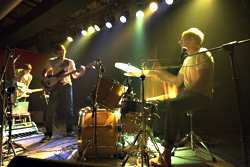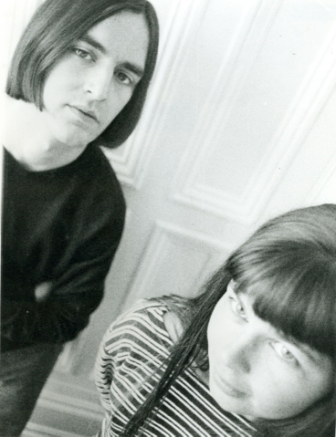Judging something—a person, a book, a record—simply by its cover alone usually leads to disappointment. While the outside might be physically attractive, in many cases, the inside is usually nothing but a muddled mess of God knows what.
But in the case of Portland trio Menomena, the band has crafted two records this decade that are clearly visionary, in both the literal and figurative sense. The group’s 2004 debut album, I Am the Fun Blame Monster (an anagram of “The First Menomena Album”), was packaged as a 64-page flip book of band members Justin Harris, Danny Seim, and Brent Knopf playing bass, drums, and piano, respectively. Even the most conscious critic, at first glance, would assume this packaging was a crafty and playful way of introducing the band (it certainly is). But the flickering images of three musicians in motion only scratch the surface of the group’s completely unique take on song creation.
What makes Menomena different from any other rock band working today is their extraordinarily special song construction/deconstruction with Deeler, a Max/MSP computer application designed by Knopf that records and stores loops of the instrumentation in its memory, which the band then pieces together.
“It’s really a glorified looping pedal,” says Harris, who plays bass, saxophone, and guitar and sings. “It creates this smorgasbord which we get to go back and fix. It’s kind of fun to go back and find something that jumps out at you. You can breathe a whole new life into it.”
Musically, I Am the Fun Blame Monster is a multilayered work of art—rich with piano pop ballads, jazzy sax toots, Nick Cave–like crooning, elegant harmonies and melodies, twinkling bells, fuzzy post-punk dirges, hip-hop-worthy breaks, and experimental meanderings. But because of how it was recorded and constructed, people really took notice of that minor detail, including the ever-picky indie tastemakers at Pitchfork, who gave it an exceptionally rare 8.7 rating.
“They can seriously ruin careers,” says Harris. “I am thankful for the people at Pitchfork. Our album sold well locally, and then all of a sudden, we had a thousand orders coming in virtually overnight.”
It can be said that art is really something dear to Menomena’s heart. After I Am the Fun Blame Monster, the band was asked to compose a soundtrack to a modern dance performance taking part at the T:BA:04 Arts Festival in Portland. The band laid out three 17- and 18-minute instrumental songs for it, and later recorded them for small Portland label FilmGuerrero, who released the disc, titled Under an Hour, last year.
“That was a new experience. And it was a really good experience,” says Harris. “It was a departure from what we normally do. We always try to have a strong philosophy to do what we want to do at any given time.”
At that time, the band was talking with Barsuk Records about doing a record, but declined their offer. Six months later, the label came barking again, and the band accepted. Not only did they ink a deal for their just-released Friend and Foe, but it led to a fruitful alliance between FilmGuerrero and Barsuk. “We want to be able to do [more experimental] things like [Under an Hour] at any given time and have a home for it,” says Harris. “We’re going to release all our vinyl with FilmGuerrero.”
Friend and Foe is a culmination of the three members’ unique artistic vision, written over the span of a year and a half.
“We write separately, then bring it into the arena. The good thing about Deeler is that we’re still working with parts that were played by other bandmates. It’s never three solo projects going on,” says Harris. “But because of that process, working individually, then coming together, it causes a lot of the problems as well. We’re pretty strong-headed in our opinions.”
Within any band as tight-knit as Menomena, who have been playing together since 2000 and have been feeding off each other consistently since, there is obviously going to be some conflict—which may explain the album title and lyrics to songs like “My My” (“What if all my enemies were dead/And I could forget everything they said”) and “Boyscout’n” (“I once believed you were my savior, but now you’re nothing but a traitor”).
“Once we were able to listen to it as a whole, we saw how many songs had parallels. There are a lot of similarities,” says Harris.
The growth that’s shown on Friend and Foe is astronomical. The songs are still just as unpredictable as those on I Am the Fun Blame Monster, but the band seems to have found out how to turn the crafty, introspective lyricism and an impulsive, buoyant melody into something totally beautiful and dramatic.
Likewise, the album is extremely eye-catching, in part due to the colorful, wildly detailed illustrations by Craig Thompson, author of the graphic novel Blankets. Each of the six illustrations on the die-cut front cover, sleeve, tray liner, and back cover (think Led Zeppelin’s Physical Graffiti, the Rolling Stones’ Some Girls, or New Order’s floppy disk–inspired “Blue Monday” single) creates a visually twisted world of cartoon animals, dragons, trees, pirates, ghosts, aliens, elves, fungi, speak-bubbles, and eyeless creatures, among other things, that were inspired by the lyrics of the songs. “He was doing all the drawing based on the songs and what he was hearing,” says Harris.
The CD itself, when placed in the tray, acts as a revolving wheel (think Led Zeppelin III) that reveals the track titles, singularly, through the die-cut holes along with different sets of eyes that peak through the aforementioned creatures’ eye sockets. It is easily one of the most well-thought-out, beautifully designed albums to come out in these days of digital downloading
“The physical aspect of an album has to be there. Rather than making a vehicle for the CD, we do it to make it worth it for people to buy this thing,” says Harris, “[Album art] is a dying form, but it doesn’t have to be. It is important to us to have the aesthetics be equal [to] if not greater than the music itself.”






